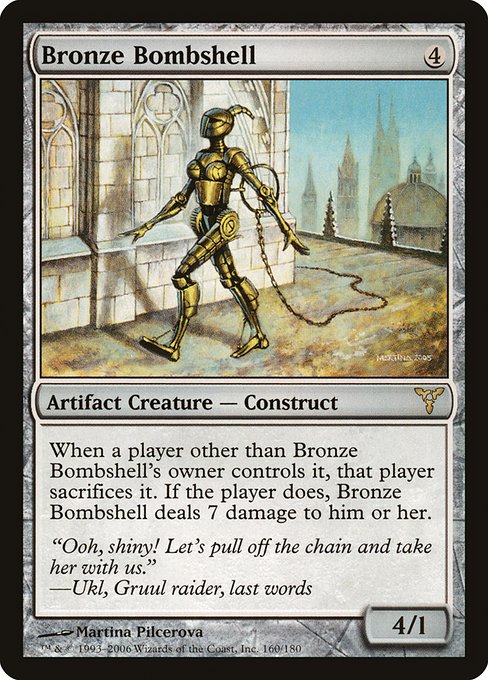
Image courtesy of Scryfall.com
Strategic Echoes: How Bronze Bombshell Shapes MTG Metagame Trends
In Dissension’s bustling, politics-first atmosphere, a rare artifact crept into the conversation not with flashy mana rocks or cathedrals of control, but with a quiet, existential reminder: power in this multiverse is precarious, and ownership is everything. Bronze Bombshell is that reminder made of brass and circuitry—a construct that costs four mana and clocks in at a sturdy 4/1, but carries a built-in governance mechanism that rewards vigilance and punishes improvisation. Its ability text reads like a policy note: when a player other than its owner controls it, that player sacrifices it. If that happens, the Bombshell deals 7 damage to that very player. The result? A metagame texture where the simplest move—grabbing an opponent’s artifact off the battlefield—carries cost, risk, and a potential for dramatic blowback. 🧙♂️🔥 The core idea is elegantly punishing: control-changing effects do not come for free, and in a robust, multi-player environment, the owner of Bronze Bombshell gains a political leverage point. The moment someone other than the owner asserts control, the Bombshell asserts its governance by forcing a sacrifice. The kicker—the 7 damage—ensures there’s a tangible price to pay, not just for the controller but for the position they’ve chosen to take. The dynamic creates a delicate balance: you want to use stolen assets to advance your board presence, yet you know this artifact will retaliate in a way that can sting at a critical moment. It’s a small but potent nudge toward caution, and in many tables, that caution can be the difference between toppling a plan and watching it crumble. ⚔️ From a metagame perspective, the Bombshell nudges players toward stronger artifact protection, tighter coordination in colorless or artifact-centric decks, and more deliberate consideration of “ownership politics.” In this era of heavy control mirrors and storied theft effects, a card that punishes theft with a burn is a reminder that board presence isn’t just about mana efficiency—it’s about trust, and about which faction controls what on the field. In multiplayer formats like Commander, where alliances are fluid and backstabbings are common, Bronze Bombshell becomes a tiny, brass-wrought referee—one that does not shy away from calling foul when someone tries to hijack a turn’s momentum. The flavor text—the sly lines of a Gruul raider’s last words—plays perfectly with the card’s mechanical ethos: shiny objects lure, but ownership carries a price. The art by Martina Pilcerova gives us that tactile moment of discovery and danger, a visual cue that this is not merely a tool but a compact of law and risk. 🎨 Strategically, many players treat Bronze Bombshell as a “keep away” asset. If you own it, you can use the threat of forced sacrifice to deter non-owners from grabbing it outright, especially if there are other bodies on the board that rely on stolen permanence to surge. The counterplay, of course, is to remove the Bombshell before it can tax you into submission. But the card’s presence reshapes decision trees: it encourages more cautious capture effects, favors protection-oriented strategies around artifacts, and makes political play a genuine factor in planning. In Legacy and Vintage environments, where artifact-based lines can be explosive, the Bombshell’s effect adds a layer of asymmetry that can tip the balance in a handful of games—especially when you’re aiming to avoid becoming a pawn in someone else’s plan. It’s not the flashiest finisher, but it operates as a steady, disruptive force in a crowd-control metagame. 🔥 The design voice behind Bronze Bombshell aligns with a broader trend in MTG during the set’s era: cards that create “ownership sovereignty” dynamics. When a battlefield can be commandeered, the owner’s role becomes more critical, and the table’s negotiation becomes as important as the card’s stats. The Bombshell doesn’t simply punish theft; it elevates it to a strategic decision about tempo, pressure, and risk management. In a meta where players seek to swing the board with big token armies, “steal and survive” decks must account for the possibility that the steal itself could backfire in dramatic fashion. It’s a tiny mechanical microcosm of the set’s political vibe—rough edges, brass surfaces, and a reminder that sometimes the best way to win is to keep others from winning at your expense. 🧭 For players looking to weave Bronze Bombshell into a modern deck, a few practical takeaways emerge. First, consider boards that reward ownership clarity: blue-control shells that rely on stealing or reusing artifacts might want to patch in ways to ignore a stolen Bombshell’s impact or to exploit the temporary control for your own advantage before the sacrifice hits. Second, artifact-heavy, jail-style strategies can leverage the Bombshell as a deterrent against raid-style plays from opponents who would otherwise seize critical pieces. Finally, in Commander circles, the Bombshell invites robust political play: talk, neigh-say, and temporary peace agreements can all hinge on a single brass artifact, making your table more engaged and more unpredictable in a good way. And if you’re waiting for the perfect moment—well, sometimes the perfect moment is simply the next time someone tries to steal your bombshell. 💎 If you’re curious to explore more about how micro-interactions like Bronze Bombshell ripple through the broader MTG ecosystem, we’ve gathered a handful of related reads from across our network. Dive into design conversations, curve-building, and data-driven analysis that illuminate how small cards shape huge strategies:More from our network
- https://blog.digital-vault.xyz/blog/post/designing-chatbots-for-higher-user-engagement/
- https://blog.digital-vault.xyz/blog/post/perfect-mana-curve-with-daunting-defender-for-aggro-decks/
- https://blog.rusty-articles.xyz/blog/post/zero-point-parallax-corrections-illuminate-a-distant-blue-white-star-in-scorpius/
- https://blog.digital-vault.xyz/blog/post/cross-matching-astrometric-data-with-spectroscopic-surveys-reveals-a-distant-blue-giant/
- https://blog.rusty-articles.xyz/blog/post/blue-hot-star-sheds-light-on-five-parameter-astrometry/